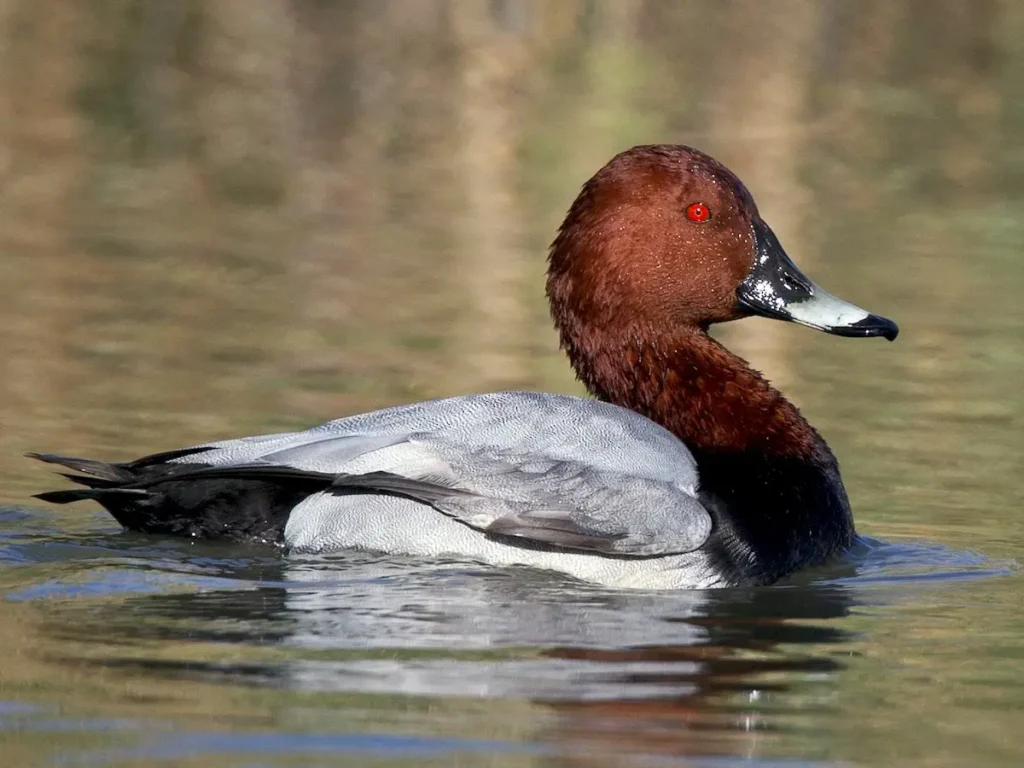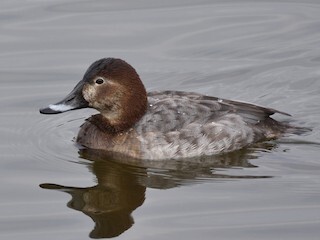Common Pochard


Scientific name
Aythya ferina
Alternative names
Also known as the European Pochard, Eurasian Pochard, or simply Pochard in the UK.
Measurements
| Feature | Range |
|---|---|
| Length | 42–49 cm (17–19 in) |
| Wingspan | 72–82 cm (28–32 in) |
| Weight | 467–1,240 g (16.5–43.7 oz); males are heavier than females |
Status
The Common Pochard is listed as Vulnerable on the IUCN Red List due to significant population declines across Europe and Asia. It is protected under the Agreement on the Conservation of African-Eurasian Migratory Waterbirds (AEWA). Major threats include wetland loss, overhunting, introduced predators such as mink, and urban development.
Identification
A medium-sized, round-bodied diving duck with a sloping forehead and long bill. Males have rich chestnut heads and necks, black breasts and tails, and pale grey bodies finely patterned with wavy lines. Their eyes turn bright red in the breeding season, and their bills show a wide blue-grey band near the tip. Females are dull brown with greyish bodies and brown eyes, while juveniles resemble females but show a yellow-olive iris. In flight, the pale upper wings and fast wingbeats make them easy to spot among mixed flocks of diving ducks.
Voice
Generally quiet, though males may give a soft whistling call during courtship. Females produce a low growling krrr when disturbed or alarmed. Ducklings give short, two- to four-note contact calls that become sharper when distressed.
Diet
Feeds mainly by diving, often at night. Their diet includes aquatic plants, seeds, small fish, mollusks, and insects. Pochards often feed near Bewick’s and Whooper Swans, taking advantage of food stirred up by the swans’ movements—a behavior that greatly increases their feeding success.
Behavior
Highly social and often seen in large mixed flocks with other diving ducks in winter. They are fast fliers, reaching speeds up to 80 km/h (50 mph). Pochards dive smoothly, staying underwater for several seconds at a time. They are migratory and travel long distances between breeding and wintering sites, often flying at night.
Distribution
Breeds across northern and temperate Europe, western Asia, and Siberia. Winters farther south and west, including the British Isles, Mediterranean, and southern Asia. Small numbers are seen as vagrants in North America, mainly in Canada and the U.S., and occasionally as far as Colombia.
Habitat
Prefers large freshwater lakes, marshes, and deep ponds with plenty of vegetation. During winter, they move to sheltered coastal waters, estuaries, and reservoirs. They choose breeding sites with dense cover near the water’s edge for nesting and safety from predators.
Breeding
Nests are built by the female on the ground close to water or on floating vegetation, hidden among reeds or grasses. The female lays 8–10 pale greenish-grey eggs, one each day, and begins incubating only after the clutch is complete. Incubation lasts around 25 days, and ducklings leave the nest shortly after hatching. They can feed themselves and fledge in about 50–55 days. Parasitic egg-laying, or egg dumping, is common—females often lay eggs in each other’s nests or even in the nests of other duck species such as the Red-crested Pochard.
Wintering
Migrates south and west to warmer wetlands after breeding. Large numbers winter in southern Europe, North Africa, and South Asia, where they gather in dense flocks on lakes and coastal lagoons. In the British Isles, many stay through the winter after migrating from Russia and Scandinavia.
Conservation
Once abundant, the Common Pochard has seen sharp declines in parts of Europe—up to 40% over the last two decades. Habitat loss, hunting, pollution, and predation by American mink and crows have reduced nesting success. Conservation efforts focus on wetland restoration, predator control, and international monitoring programs under AEWA. Collaboration across countries remains difficult due to language and policy differences, but the species is now a priority for European wetland protection projects.
